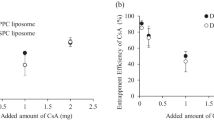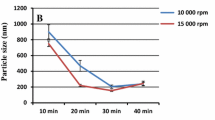Abstract
Purpose
To develop a liposomal system with high drug loading (DL) for intravenous (i.v.) delivery of a poorly water-soluble basic drug, asulacrine (ASL).
Methods
A thin-film hydration and extrusion method was used to fabricate the PEGylated liposomal membranes followed by a freeze and thaw process. A novel active drug loading method was developed using ammonium sulphate gradient as an influx driving force of ASL solubilized with sulfobutyl ether-β-cyclodextrin (SBE-β-CD). DL was maximized by optimizing liposomal preparation and loading conditions. Pharmacokinetics was evaluated following i.v. infusion in rabbits.
Results
Freeze-thaw resulted in unilamellar liposome formation (180 nm) free of micelles. Higher DL was obtained when dialysis was used to remove the untrapped ammonium sulphate compared to ultracentrifuge. The pH and SBE-β-CD level in the loading solution played key roles in enhancing DL. High DL ASL-liposomes (8.9%w/w, drug-to-lipid mole ratio 26%) were obtained with some drug “bundles” in the liposomal cores and were stable in a 5% glucose solution for >80 days with minimal leakage (<2%). Surprisingly, following administration of ASL-liposomes prepared with or without SBE-β-CD, the half-lives were similar to the drug solution despite an increased area under the curve, indicating drug leakage from the carriers.
Conclusions
High liposomal DL was achieved with multiple strategies for a poorly-water soluble weak base. However, the liposomal permeability needed to be tailored to improve drug retention.







Similar content being viewed by others
Abbreviations
- ASL:
-
Asulacrine
- ASL-L:
-
Asulacrine liposomes
- Cryo-TEM:
-
Cryo-Transmission electron microscopy
- DL:
-
Drug loading
- DLS:
-
Dynamic light scattering
- EE:
-
Entrapment efficiency
- EPR:
-
Enhanced permeability and retention
- PDI:
-
Polydispersity index
- PEG:
-
Polyethylene glycol
- PIP:
-
Post-injection precipitation
- RES:
-
Reticuloendothelial system
- SBE-β-CD:
-
Sulfobutyl ether-β-cyclodextrin
- TFH:
-
Thin-film hydration
References
Peer D, Karp JM, Hong S, Farokhzad OC, Margalit R, Langer R. Nanocarriers as an emerging platform for cancer therapy. Nat Nanotechnol. 2007;2(12):751–60.
Maeda H, Wu J, Sawa T, Matsumura Y, Hori K. Tumor vascular permeability and the EPR effect in macromolecular therapeutics: A review. J Control Release. 2000;65(1):271–84.
Taurin S, Nehoff H, Diong J, Larsen L, Rosengren RJ, Greish K. Curcumin-derivative nanomicelles for the treatment of triple negative breast cancer. J Drug Target. 2013;21(7):675–83.
Xu H, Paxton J, Lim J, Li Y, Zhang W, Duxfield L, et al. Development of high-content gemcitabine pegylated liposomes and their cytotoxicity on drug-resistant pancreatic tumour cells. Pharma Res. 2014;1–10.
Cui Y, Wu Z, Liu X, Ni R, Zhu X, Ma L, et al. Preparation, safety, pharmacokinetics, and pharmacodynamics of liposomes containing Brucea javanica oil. AAPS PharmSciTech. 2010;11(2):878–84.
Gubernator J. Active methods of drug loading into liposomes: recent strategies for stable drug entrapment and increased in vivo activity. Expert Opin Drug Deliv. 2011;8(5):565–80.
Bolotin EM, Cohen R, Bar LK, Emanuel N, Ninio S, Barenholz Y, et al. Ammonium Sulfate Gradients for Efficient and Stable Remote Loading of Amphipathic Weak Bases into Liposomes and Ligando liposomes. J Liposome Res. 1994;4(1):455–79.
Clerc S, Barenholz Y. Loading of amphipathic weak acids into liposomes in response to transmembrane calcium acetate gradients. Biochim Biophys Acta. 1995;1240(2):257–65.
Gubernator J, Chwastek G, Korycińska M, Stasiuk M, Grynkiewicz G, Lewrick F, et al. The encapsulation of idarubicin within liposomes using the novel EDTA ion gradient method ensures improved drug retention in vitro and in vivo. J Control Release. 2010;146(1):68–75.
Li C, Cui J, Wang C, Li Y, Zhang L, Xiu X, et al. Novel sulfobutyl ether cyclodextrin gradient leads to highly active liposomal irinotecan formulation. J Pharm Pharmacol. 2011;63(6):765–73.
Taggar AS, Alnajim J, Anantha M, Thomas A, Webb M, Ramsay E, et al. Copper–topotecan complexation mediates drug accumulation into liposomes. J Control Release. 2006;114(1):78–88.
Zucker D, Marcus D, Barenholz Y, Goldblum A. Liposome drugs’ loading efficiency: A working model based on loading conditions and drug's physicochemical properties. J Control Release. 2009;139(1):73–80.
Boman NL, Mayer LD, Cullis PR. Optimization of the retention properties of vincristine in liposomal systems. Biochim Biophys Acta. 1993;1152(2):253–8.
Modi S, Xiang T-X, Anderson BD. Enhanced active liposomal loading of a poorly soluble ionizable drug using supersaturated drug solutions. J Control Release. 2012;162(2):330–9.
Baguley BC, Denny WA, Atwell GJ, Finlay GJ, Rewcastle GW, Twigden SJ, et al. Synthesis, antitumor activity, and DNA binding properties of a new derivative of amsacrine, N-5-dimethyl-9-[(2-methoxy-4-methylsulfonylamino) phenylamino]-4-acridinecarboxamide. Cancer Res. 1984;44(8):3245–51.
Schneider E, Darkin SJ, Lawson PA, Ching L-M, Ralph RK, Baguley BC. Cell line selectivity and DNA breakage properties of the antitumour agent N-[2-(Dimethylamino) ethyl] acridine-4-carboxamide: role of DNA topoisomerase II. Eur J Cancer Clin Oncol. 1988;24(11):1783–90.
Fyfe D, Price C, Langley R, Pagonis C, Houghton J, Osborne L, et al. A phase I trial of amsalog (CI-921) administered by intravenous infusion using a 5-day schedule. Cancer Chemother Pharmacol. 2001;47(4):333–7.
Sklarin NT, Wiernik PH, Grove WR, Benson L, Mittelman A, Maroun JA, et al. A phase II trial of CI-921 in advanced malignancies. Inves New Drugs. 1992;10(4):309–12.
See E, Zhang W, Liu J, Svirskis D, Baguley BC, Shaw JP, et al. Physicochemical characterization of asulacrine towards the development of an anticancer liposomal formulation via active drug loading: Stability, solubility, lipophilicity and ionization. Int J Pharm. 2014;473(1–2):528–35.
Yalkowsky SH, Valvani SC, Johnson BW. In vitro method for detecting precipitation of parenteral formulations after injection. J Pharma Sci. 1983;72(9):1014–7.
Wu Z, Hassan D, Shaw JP. In-vitro prediction of bioavailability following extravascular injection of poorly soluble drugs: an insight into clinical failure and the role of delivery systems. J Pharm Pharmacol. 2013;65(10):1429–39.
Powis G, Kovach JS. Disposition of bisantrene in humans and rabbits: evidence for intravascular deposition of drug as a cause of phlebitis. Cancer Res. 1983;43(2):925–9.
Hu K, Zhu L, Liang H, Hu F, Feng J. Improved antitumor efficacy and reduced toxicity of liposomes containing bufadienolides. Arch Pharm Res. 2011;34(9):1487–94.
Liu X, Sun W, Zhang B, Tian B, Tang X, Qi N, et al. Clarithromycin-loaded liposomes offering high drug loading and less irritation. Int J Pharm. 2013;443(1):318–27.
Sriwongsitanont S, Ueno M. Effect of Freeze-Thawing Process on the Size and Lamellarity of PEG-Lipid Liposomes. Open Colloid Sci J. 2011;4:1–6.
Johnsson M, Edwards K. Liposomes, disks, and spherical micelles: aggregate structure in mixtures of gel phase phosphatidylcholines and poly (ethylene glycol)-phospholipids. Biophys J. 2003;85(6):3839–47.
Taratula O, Dani RK, Schumann C, Xu H, Wang A, Song H, et al. Multifunctional nanomedicine platform for concurrent delivery of chemotherapeutic drugs and mild hyperthermia to ovarian cancer cells. Int J Pharm. 2013;458(1):169–80.
Fritze A, Hens F, Kimpfler A, Schubert R, Peschka-Süss R. Remote loading of doxorubicin into liposomes driven by a transmembrane phosphate gradient. Biochim Biophys Acta. 2006;1758(10):1633–40.
Harrigan P, Wong K, Redelmeier T, Wheeler J, Cullis P. Accumulation of doxorubicin and other lipophilic amines into large unilamellar vesicles in response to transmembrane pH gradients. Biochim Biophys Acta. 1993;1149(2):329–38.
Lee C-M, Choi Y, Huh EJ, Lee KY, Song H-C, Sun MJ, et al. Polyethylene Glycol (PEG) Modified 99mTc-HMPAOLiposome for Improving Blood Circulation and Biodistribution: The Effect of the Extent of PEGylation. Cancer Biother Radiopharm. 2005;20(6):620–8.
Vail DM, Amantea MA, Colbern GT, Martin FJ, Hilger RA. Working PK, editors Pegylated liposomal doxorubicin: proof of principle using preclinical animal models and pharmacokinetic studies. Semin Oncol. 2004;31:16–35.
Fenske DB, Cullis PR. Liposomal nanomedicines. Expert Opin Drug Deliv. 2008;5(1):25–44.
Moghimi SM, Hunter AC, Murray JC. Long-circulating and target-specific nanoparticles: Theory to practice. Pharmacol Rev. 2001;53(2):283–318.
Piel G, Piette M, Barillaro V, Castagne D, Evrard B, Delattre L. Study of the relationship between lipid binding properties of cyclodextrins and their effect on the integrity of liposomes. Int J Pharm. 2007;338(1):35–42.
Puskás I, Csempesz F. Influence of cyclodextrins on the physical stability of DPPC-liposomes. Colloids Surf B: Biointerfaces. 2007;58(2):218–24.
Lindner LH, Hossann M. Factors affecting drug release from liposomes. Expert Opin Drug Discov Devel. 2010;13(1):111–23.
Zhigaltsev IV, Maurer N, Akhong Q-F, Leone R, Leng E, Wang J, et al. Liposome-encapsulated vincristine, vinblastine and vinorelbine: a comparative study of drug loading and retention. J Control Release. 2005;104(1):103–11.
Maurer-Spurej E, Wong KF, Maurer N, Fenske DB, Cullis PR. Factors influencing uptake and retention of amino-containing drugs in large unilamellar vesicles exhibiting transmembrane pH gradients. Biochim Biophys Acta. 1999;1416(1):1–10.
Lasic D, Čeh B, Stuart M, Guo L, Frederik P, Barenholz Y. Transmembrane gradient driven phase transitions within vesicles: Lessons for drug delivery. Biochim Biophys Acta. 1995;1239(2):145–56.
Mady MM, Darwish MM. Effect of chitosan coating on the characteristics of DPPC liposomes. J Advanc Resb. 2010;1(3):187–91.
Acknowledgemnts and Disclosures
This study is a New Zealand-China Research Alliance Project funded by the New Zealand Ministry of Science and Innovation (MSI) (UOAX1102) and International Science and Technology Cooperation Program of China (2011DFG33380). The consumables were supported by a Faculty Research Development Fund from the University of Auckland to Dr Zimei Wu.
The authors declare that they have no conflicts of interest to disclose.
Author information
Authors and Affiliations
Corresponding authors
Rights and permissions
About this article
Cite this article
Zhang, W., Wang, G., Falconer, J.R. et al. Strategies to Maximize Liposomal Drug Loading for a Poorly Water-soluble Anticancer Drug. Pharm Res 32, 1451–1461 (2015). https://doi.org/10.1007/s11095-014-1551-8
Received:
Accepted:
Published:
Issue Date:
DOI: https://doi.org/10.1007/s11095-014-1551-8




